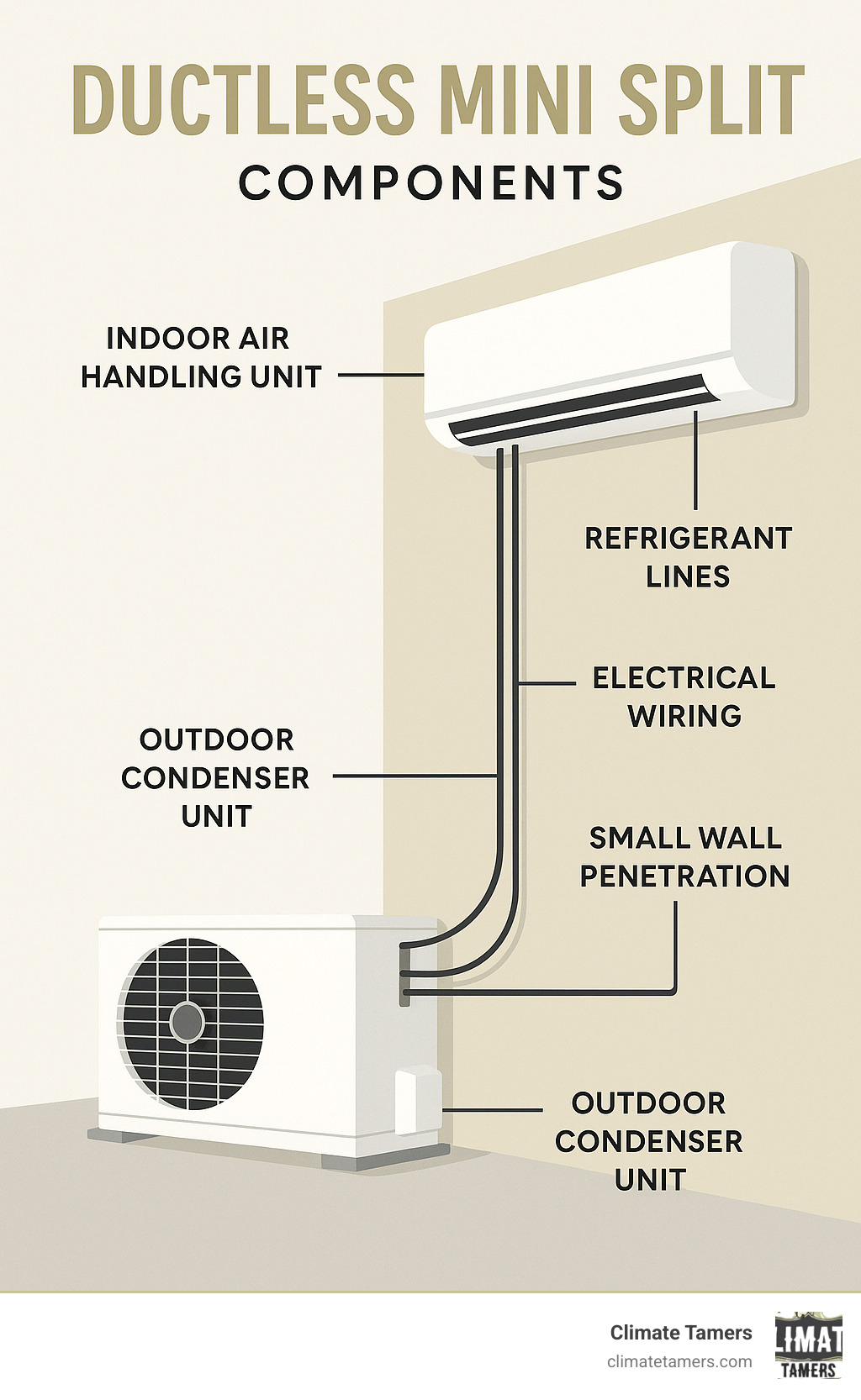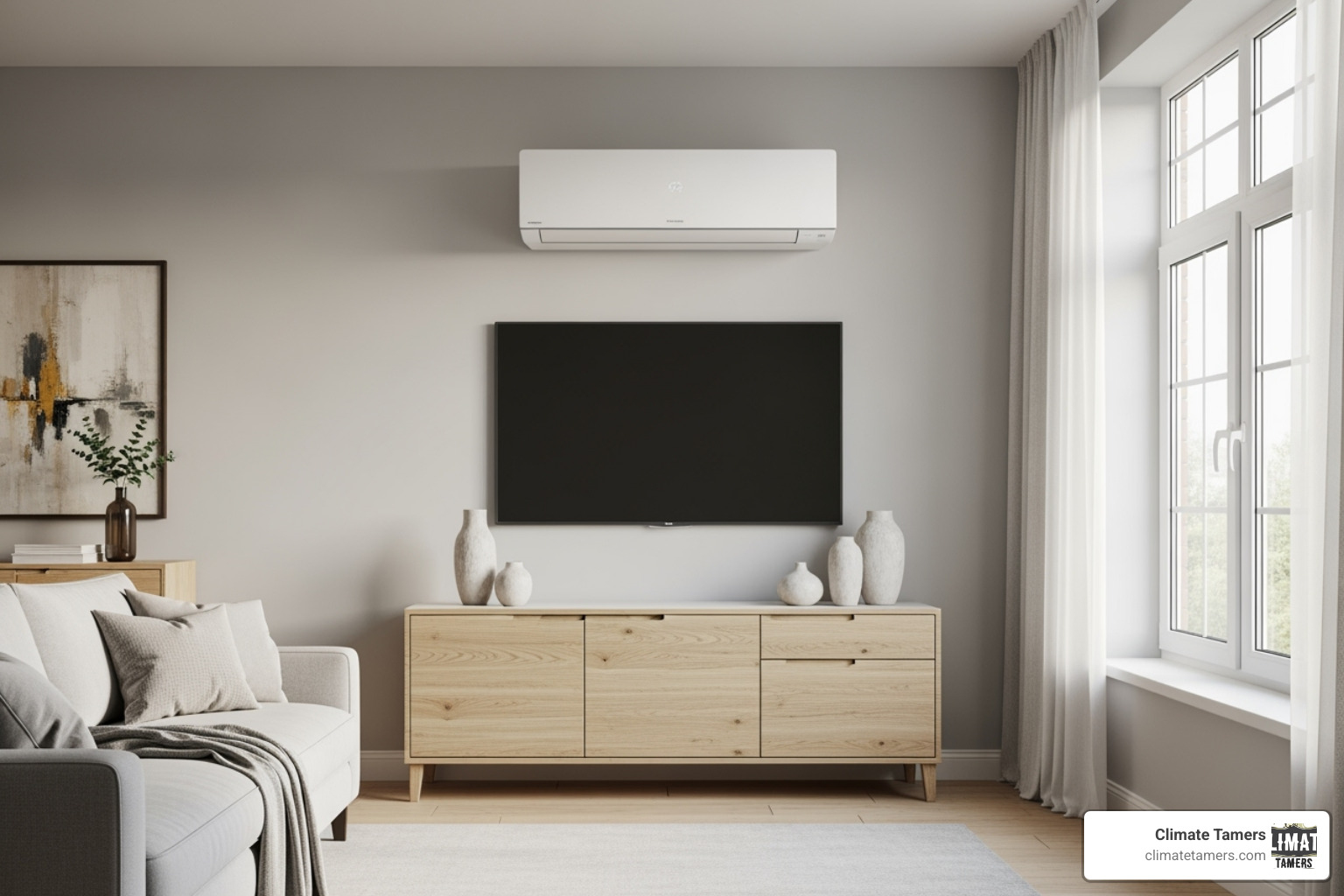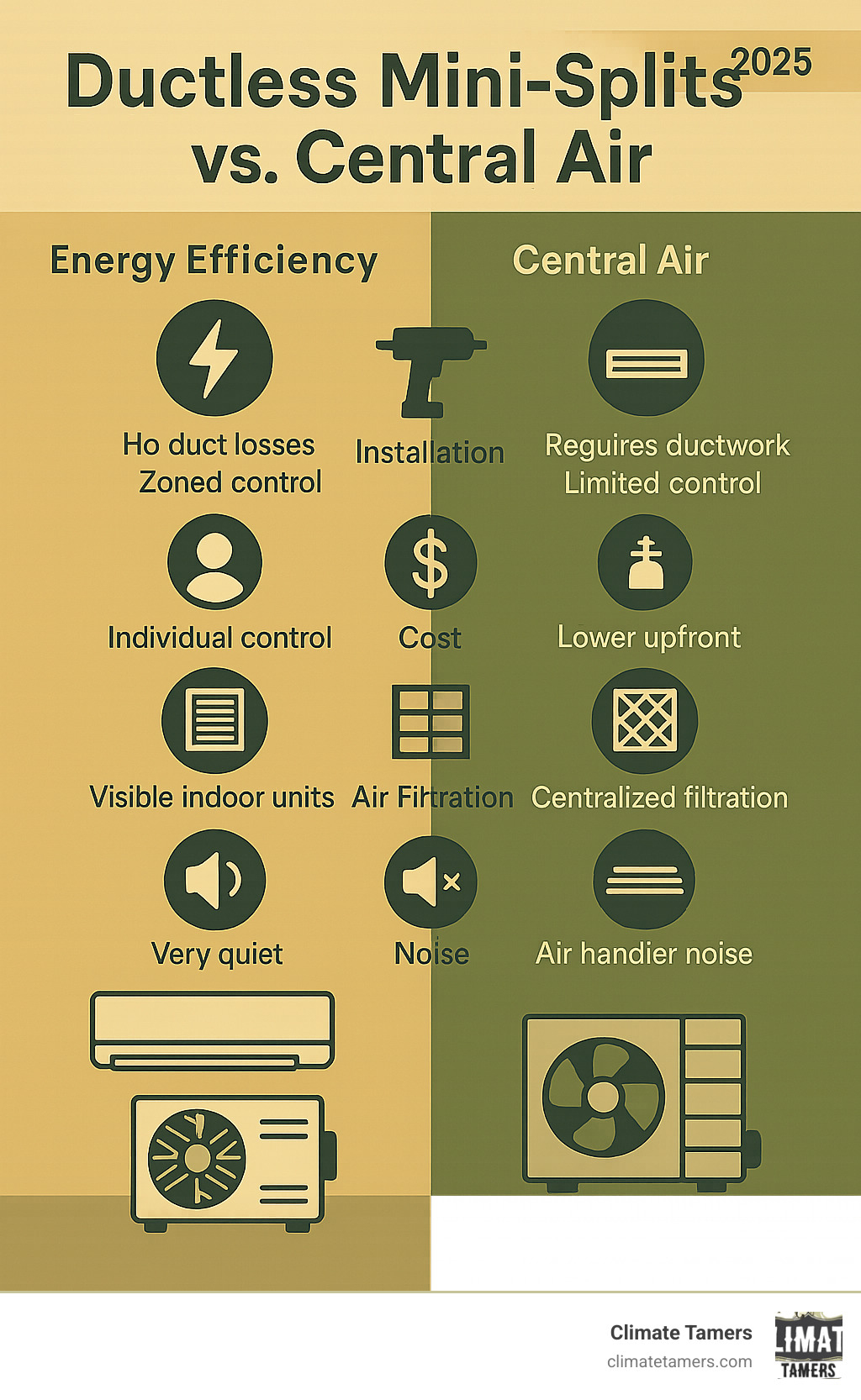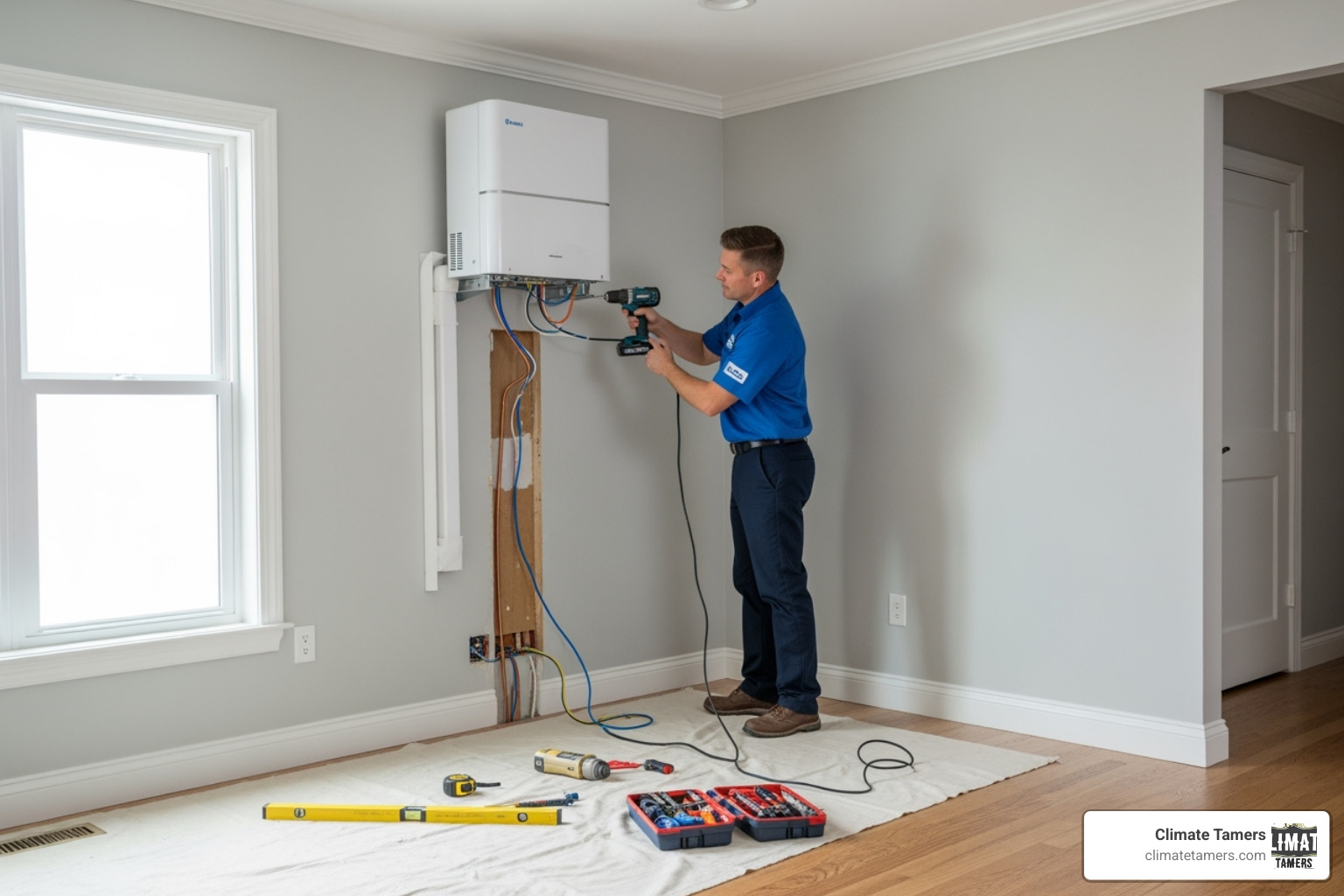Why Ductless Mini Splits Are Revolutionizing Home Comfort
A ductless mini split is a heating and cooling system with an outdoor unit connected to one or more indoor air handlers, eliminating the need for traditional ductwork. This design provides precise temperature control for individual rooms or zones with exceptional energy efficiency.
Key Benefits of Ductless Mini Splits:
- Energy Efficiency: Avoids the 30% energy loss common with ductwork.
- Zoned Comfort: Control the temperature in each room independently.
- Quiet Operation: Indoor units can be as quiet as 22dB(A).
- Flexible Installation: Requires only a small 3-inch hole through the wall.
- Year-Round Comfort: Heat pump models provide both heating and cooling.
- Smart Controls: Many models offer WiFi and app control.
For New Orleans homeowners facing high energy bills and inconsistent temperatures, ductless systems are a compelling alternative to traditional HVAC. Mini-splits deliver conditioned air directly where it’s needed, unlike central air systems that lose energy through leaky ducts.
These compact systems are ideal for homes without existing ductwork, room additions, or spaces where installing ducts is impractical. With single-zone systems for individual rooms and multi-zone systems supporting up to five indoor units, there’s a solution for nearly any home.
Modern ductless units use advanced inverter technology, allowing the compressor to adjust its speed based on demand. This maintains consistent temperatures while using less energy than traditional systems.
Understanding the Ductless Mini Split: Components and Operation
A ductless mini split system consists of an outdoor unit (condenser/compressor) connected to one or more sleek indoor air handlers. A slim conduit connects these components through a small 3-inch hole in the wall, avoiding major construction.
This conduit houses the essential connections: refrigerant lines for carrying cooling fluid, electrical wiring, and a drain line for condensation.
The magic lies in the inverter technology and variable-speed compressor. Unlike older systems that blast at full power and then shut off, a ductless mini split adjusts its speed to meet the room’s exact needs. This smart approach means the system runs steadily at lower speeds, avoiding energy-wasting stop-start cycles and resulting in consistent temperatures, quieter operation, and significant energy savings.
When choosing a system, you can select a heat pump model for both heating and cooling or an AC-only unit. For year-round comfort in New Orleans, heat pump models are the ideal choice. You can learn more in our detailed guide on Explaining Ductless Systems.
How Heat Pump Models Provide Year-Round Comfort
Ductless mini split heat pumps are essentially heat movers. They use energy transfer to move warmth from one place to another instead of burning fuel.
During the cooling cycle, the indoor unit pulls warmth from the room’s air. The refrigerant carries this heat outside, where the outdoor unit releases it. In the winter, the heating cycle reverses this process via a reversing valve. The outdoor unit collects warmth from the outside air (even cold air has heat energy) and moves it indoors.
This all-in-one solution provides both heating and cooling from a single ductless mini split system, keeping you comfortable no matter the season. The efficiency of this process is remarkable compared to traditional electric heating. For more insights, check out our article on the Benefits Ductless Heating Cooling System.
The Ductless Advantage: Why Homeowners Are Making the Switch
Homeowners are increasingly switching to ductless mini split systems for a combination of benefits that traditional systems can’t match.
The most significant advantage is energy savings. Traditional ductwork can waste over 30% of the energy you pay for through leaks and poor insulation. A ductless mini split eliminates this waste by delivering conditioned air directly into your living space.
Zoned heating and cooling is another key feature. With independently operated indoor units, you can set different temperatures for different rooms, ending thermostat battles. This approach also saves money by not heating or cooling unused spaces.
Other major benefits include quiet operation (many units are quieter than a whisper at 22dB(A)), improved air quality thanks to direct, multi-stage filtration in each unit, and flexible installation. A ductless mini split is perfect for older homes or new additions, requiring only a small hole in the wall and avoiding disruptive ductwork installation. Many models feature advanced filtration that helps Improve Home Air Quality with Ductless AC.
Comparing Mini-Splits to Traditional Central Air
Here’s a direct comparison of ductless mini splits and traditional central air systems:
| Feature | Ductless Mini-Splits | Central Air Systems |
|---|---|---|
| Energy Efficiency | High; No duct losses (can save >30% energy); Zoned control. Inverter technology optimizes performance. | Can be efficient, but significant energy loss (30%+) through ductwork. Single-zone control. |
| Installation | Relatively easy; Requires small wall penetration; No ductwork needed. Less intrusive for existing homes. | Requires extensive ductwork installation; Can be complex and disruptive, especially for retrofits. |
| Zoning | Excellent; Individual indoor units control specific rooms/zones. | Limited; Typically one thermostat controls entire home, leading to uneven temperatures. |
| Cost | Higher upfront unit cost than window units, but often more efficient long-term. No ductwork cost. | Lower unit cost than mini-splits, but high cost for ductwork installation/repair. |
| Aesthetics | Indoor units mounted on walls, ceilings, or floors; Can be less visually integrated for some. | Ducts hidden within walls/ceilings; Vents are only visible components. |
| Air Filtration | Filters on each indoor unit; Generally less robust filtration than central systems with large MERV filters. | Centralized filtration with larger, higher MERV filters possible; Ducts can accumulate dust. |
| Noise | Indoor units are very quiet (as low as 22dB(A)); Outdoor units are similar to central AC. | Indoor air handler noise from central unit and air moving through ducts. |
While a ductless mini split may have a higher upfront cost than some systems, the long-term energy savings and avoidance of ductwork expenses often make it more economical. Aesthetic considerations are personal, but modern units are designed to be sleek and unobtrusive. Regarding air filtration, mini-splits avoid the dust accumulation common in ducts. Finally, the combination of no duct losses and zoned control makes their energy consumption significantly lower than most central air systems.
Selecting Your Ideal System: Sizing, Types, and Efficiency
Choosing the right ductless mini split system is crucial for optimal performance. The first decision is between single-zone and multi-zone systems.
A single-zone system is perfect for conditioning a specific area, like a new sunroom, garage workshop, or a single problematic room. A multi-zone system connects up to five indoor units to one outdoor unit, allowing independent temperature control for multiple rooms or an entire home.
Proper sizing by BTU (British Thermal Units) is essential. An undersized system will struggle to keep up, while an oversized one will cycle inefficiently, wasting energy. Sizing requires a professional room size calculation that considers square footage, ceiling height, insulation, windows, and sun exposure to Maximize Efficiency with Ductless AC. We also verify your home’s voltage requirements, as most systems need 208/230V power.
Decoding Efficiency Ratings: SEER, EER, and HSPF
Understanding efficiency ratings helps you choose a system that saves money:
- SEER (Seasonal Energy Efficiency Ratio): This is the cooling efficiency rating over a whole season. A higher SEER means greater efficiency and lower summer energy bills. Top models can reach a 27 SEER2 rating.
- EER (Energy Efficiency Ratio): This measures cooling efficiency at a peak temperature (95°F), showing how the system performs under stress.
- HSPF (Heating Seasonal Performance Factor): For heat pumps, this measures heating efficiency over a winter season. A higher HSPF means lower heating costs. Premium models can achieve an 11 HSPF2 rating.
Higher ratings translate to lower energy bills. We recommend looking for ENERGY STAR certified models, which meet strict efficiency guidelines for guaranteed savings.
Key Factors for Choosing a Ductless Mini Split
Finding the perfect ductless mini split involves balancing several factors. We work with New Orleans homeowners to consider:
- Home Layout: Open-concept spaces may need a different setup than homes with many separate rooms.
- Climate Considerations: Our Louisiana climate demands systems with strong cooling and dehumidification capabilities.
- Number of Rooms: This determines whether a single-zone or multi-zone system is the right fit.
- Budget: We consider both the upfront investment and long-term energy savings to find a solution that makes financial sense.
- Desired Features: Smart controls, whisper-quiet operation, and advanced air filtration can greatly improve your comfort.
Installation and Costs: What to Expect
While DIY projects can be tempting, installing a ductless mini split system requires professional expertise. The process involves handling high-voltage electrical connections and refrigerant lines, where mistakes can lead to poor performance, safety hazards, and costly repairs. Professional installation ensures your system operates safely and at peak efficiency.
The investment for your ductless mini split installation depends on several factors. The system’s size (BTUs), whether it’s a single-zone or multi-zone setup, and the number of indoor units all affect the cost. Installation complexity, such as the line set length needed to connect the indoor and outdoor units and the placement of the indoor units (e.g., high-wall vs. ceiling cassette), also plays a role.
As your trusted Ductless Installation Specialist New Orleans LA, we provide a detailed assessment and transparent quote, so you know exactly what to expect.
How to Save on Your Ductless Installation
While a ductless mini split is a smart investment, there are ways to manage the upfront cost:
- Rebates and Tax Credits: We stay current on federal tax credits and local utility rebates for high-efficiency systems and can help you identify applicable savings in the Greater New Orleans area.
- Timing Your Installation: Scheduling your installation during the off-season (spring or fall) can sometimes lead to more competitive pricing and better availability.
- Getting Multiple Quotes: When comparing quotes, look beyond the price. Evaluate the equipment quality, warranty, and what’s included to ensure you’re making an apples-to-apples comparison.
- Choosing the Right Size System: Proper sizing is crucial. An oversized system costs more and runs inefficiently, while an undersized one struggles to provide comfort. We perform professional load calculations to ensure a perfect fit. Proper placement of the mini-split heads is also key for performance, as shown in this helpful resource: What is the Best Location for these Mini-Split A/C Heads in my units? (see photos).
Long-Term Care and Ideal Applications
Think of your ductless mini split system like a reliable friend – treat it well, and it’ll take care of you for years to come. The good news? These systems are refreshingly low-maintenance compared to traditional HVAC equipment.
The most important thing you can do as a homeowner is keep those filters clean. Each indoor unit has filters that work hard to catch dust, pet hair, and other airborne particles before they circulate through your home. We recommend giving them a gentle cleaning once a month, especially during those sweltering New Orleans summers when your system is working overtime.
The process couldn’t be simpler: slide the filters out (they usually pop right out), rinse them with warm water and a little mild soap, let them air dry completely, and slide them back in. Clean filters mean better airflow, less strain on your system, and cleaner air for your family. It’s amazing how such a small task can make such a big difference!
Beyond your monthly filter routine, scheduling an annual professional tune-up is one of the smartest investments you can make. Our technicians will give your system a thorough once-over – cleaning coils, checking refrigerant levels, inspecting electrical connections, and making sure everything is humming along as it should. This preventive care catches small issues before they become big headaches and keeps your system running efficiently, truly Maintaining the Efficiency of Ductless HVAC.
While ductless mini split systems are generally rock-solid reliable, they’re not immune to the occasional hiccup. If your unit starts blowing warm air when you’re expecting a cool breeze, making unusual noises, or simply refuses to turn on, it’s time to call in the pros. We’ve put together comprehensive guides on Troubleshooting Ductless AC Issues to help you understand what might be happening, but for proper diagnosis and repairs, always trust a qualified technician.
When is a Ductless Mini Split the Perfect Choice?
A ductless mini split is the ideal solution in many scenarios, especially in the Greater New Orleans area:
- Homes without Existing Ductwork: Avoids the cost and disruption of installing a full duct system in older homes.
- Room Additions and Conversions: Provides efficient, standalone climate control for new spaces like sunrooms, home offices, or converted garages.
- Sunrooms and Enclosed Patios: Effectively manages the unique heating and cooling challenges of these window-heavy spaces.
- Downsizing Energy Use: Zoned control allows you to heat or cool only the rooms you’re using, significantly cutting energy consumption.
- Supplementing Existing Systems: Adds targeted comfort to problem areas (like a hot upstairs bedroom) without overworking your central HVAC, helping to Improve Home Comfort with Ductless AC.
Frequently Asked Questions about Ductless Systems
We enjoy discussing ductless mini split systems with homeowners, and a few questions come up frequently. Here are answers to the most common ones.
How much does a ductless mini split cost to install?
This is a top question for every homeowner. The final cost of a ductless mini split installation is unique to each home and depends on several key factors. The system size (BTUs), the number of zones (indoor units), and the overall installation complexity—such as the length of the refrigerant lines and electrical work required—all influence the price. While the upfront investment can be significant, we provide detailed, transparent quotes so you understand the full value. Most homeowners find the long-term energy savings and superior comfort make it a worthwhile investment.
Are mini-splits worth the investment?
For most New Orleans homeowners, the answer is a resounding yes. The value of a ductless mini split comes from several key benefits. The high energy efficiency eliminates the 30%+ energy loss common with ductwork, leading to lower utility bills. Zoned comfort allows you to control temperatures room-by-room, enhancing comfort and saving money. For homes without existing ductwork, a mini-split is often far more cost-effective and less disruptive than installing a traditional central air system.
What maintenance does a ductless mini split require?
Ductless mini split systems are known for being low-maintenance. Your primary responsibility is monthly filter cleaning. Simply wash the reusable filters in each indoor unit to maintain clean air and system efficiency. The second part is scheduling an annual professional servicing. Our technicians will perform a thorough tune-up, checking refrigerant levels, cleaning coils, and inspecting all components to ensure your system runs reliably for years. This simple routine keeps your system in peak condition.
Your Partner for an Energy-Efficient New Orleans Home
A ductless mini split system is one of the smartest investments you can make to transform your home’s comfort and energy efficiency. By delivering targeted heating and cooling exactly where you need it, these systems eliminate the energy waste of traditional ductwork and put you in complete control of your environment, room by room.
For homeowners throughout the Greater New Orleans area, including Metairie and Kenner, this technology is a perfect fit for our demanding climate. A professionally installed ductless mini split provides powerful cooling for humid summers and reliable heating for chilly winters, all while delivering significant long-term savings on your utility bills.
At Climate Tamers, we know that choosing a new HVAC system is a major decision. We’ve built our reputation on exceptional customer service, promptness, and a commitment to earning your trust for life. Our team understands the unique challenges of Louisiana’s climate and is passionate about designing the perfect solution for your home, lifestyle, and budget.
Ready to explore your options? The experts at Climate Tamers are here to help. Contact us for professional heating services in New Orleans, LA.








